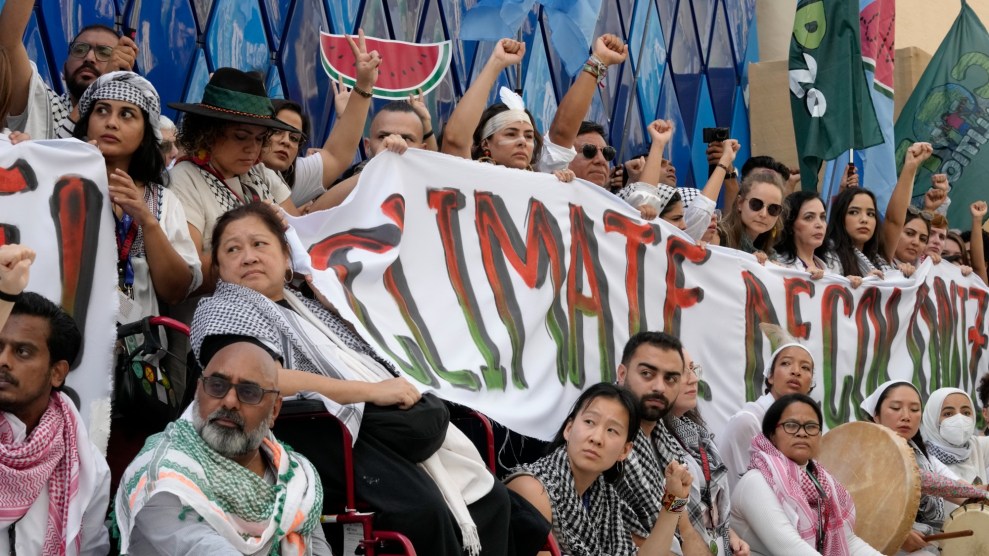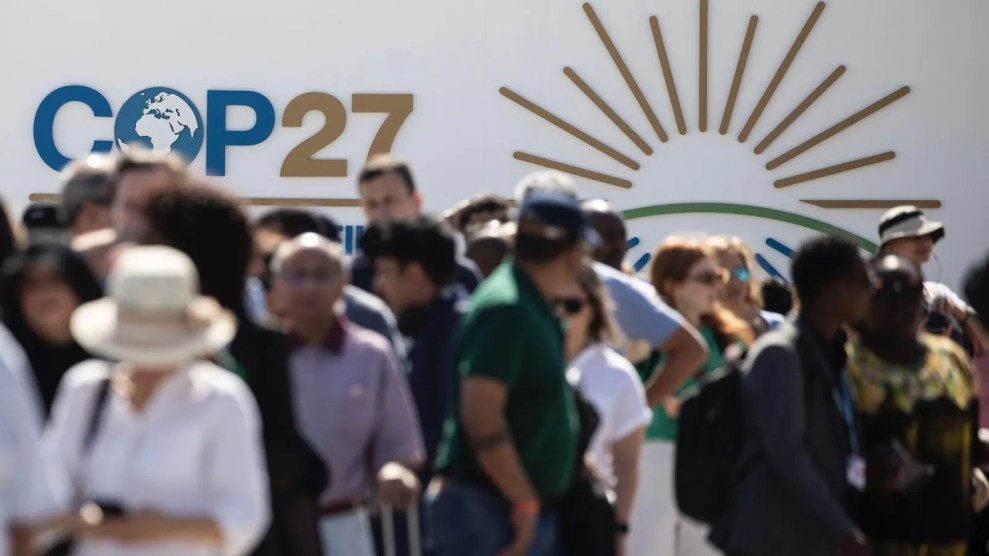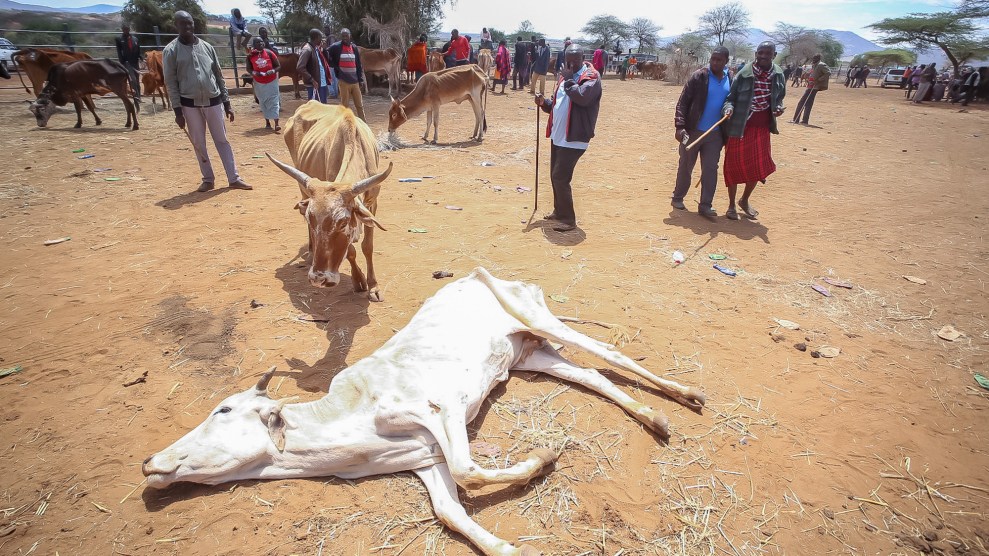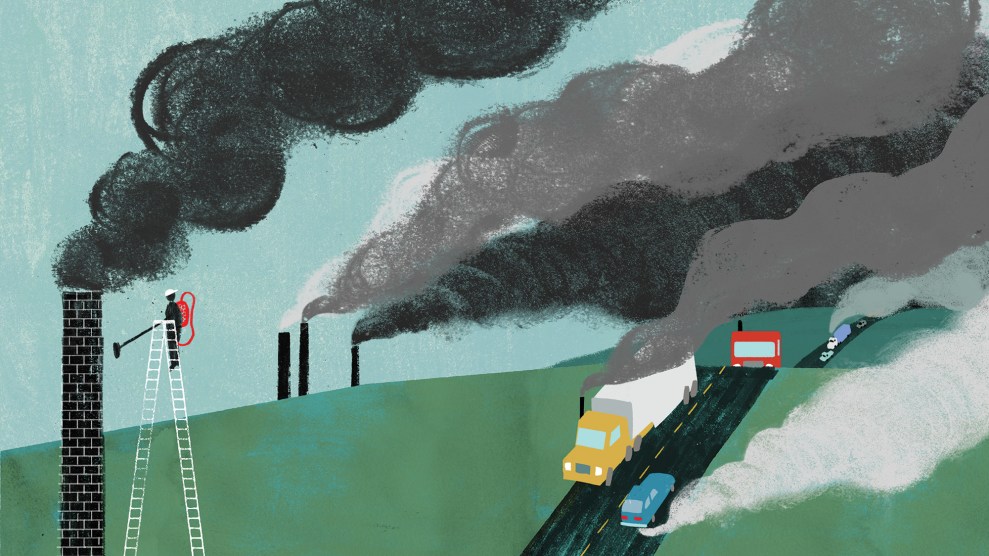
Al Gore at the COP28 climate summit.Kamran Jebreili/AP
This story was originally published by Grist and is reproduced here as part of the Climate Desk collaboration.
The United Nations climate summit in Dubai promises no shortage of drama in its final days—in part because negotiations over whether or not to phase out global fossil fuel use appear to have collapsed. One major goal of this year’s conference, known as COP28, is a “global stocktake” documenting the world’s climate progress and next steps on climate action. But as of Monday, any reference to ending oil and gas use had disappeared from the draft text, leading to widespread anger among climate advocates. Former Vice President Al Gore declared that the conference was “on the verge of complete failure.”
But the well-publicized debate over fossil fuels threatens to overshadow another major question dogging negotiations as the clock runs out: whether or not world leaders can agree on how to adapt their countries’ infrastructure to withstand global warming. As climate-driven disasters continue to make headlines around the world, the fate of millions in especially vulnerable regions such as Africa and Southeast Asia hinges on this question.
Though hundreds of international negotiators have spent the past fortnight tangling over a convoluted document that outlines how countries will adapt to climate change, they haven’t yet reached consensus on who exactly will pay for the phenomenally expensive undertaking—or even how to define successful climate adaptation in the first place. As the end of the conference approaches, stakeholders who spoke to Grist described the most recent draft text of the so-called global goal on adaptation as “watered-down,” “vague,” and “confusing.”
The latest text is “much weakened,” said Pratishtha Singh, a policy analyst at the Canadian chapter of the Climate Action Network, an international advocacy organization. “It’s far from enough in terms of what’s needed by developing countries.”
The “global goal on adaptation” is a sweeping framework that is supposed to guide how the world prepares for floods, fires, droughts, and other climate disasters. It’s also one of the last and biggest puzzle pieces in the implementation of the landmark Paris Agreement.
The 2015 accord had three main pillars: mitigating future climate change by reducing carbon emissions, adapting to future climate disasters, and redressing the loss and damage that can’t be prevented. In the years since it was signed, countries have set goals for cutting carbon emissions and, much more recently, committed hundreds of millions of dollars to a loss-and-damage fund, but they haven’t yet agreed on a framework for climate adaptation.
This year’s COP is the final deadline for putting that framework together, but talks have moved at a snail’s pace in Dubai as negotiators clash over key issues. Despite holding at least eight technical discussions on the adaptation goal earlier this year, negotiators failed to agree on a draft document by the end of the conference’s first week, a sign of dismal progress. A parallel discussion about how vulnerable countries should design their national adaptation plans also broke down, and negotiators have punted that debate to a meeting in Bonn, Germany, next summer.
The reasons for the logjam are multiple. For one, the geopolitics of adaptation finance are highly contentious. In the past, rich countries in Europe and North America have promised to support adaptation in more vulnerable countries, but they have overwhelmingly failed to meet their previous commitments—and even those commitments were hundreds of billions of dollars short of what experts agree is needed.
Negotiators from Africa and Southeast Asia entered the adaptation talks at COP28 seeking an acknowledgment that wealthy nations need to do more, plus a mechanism for monitoring international aid, which they say will help ensure that rich countries don’t renege on their funding commitments. Rich countries, however, sought to restrict the final agreement to a discussion of how to develop and implement adaptation policy.
“The main issue is the financial part,” said Idy Niang, a Senegalese negotiator who represents a bloc of the world’s least economically developed countries, during the first week of COP28. “We are not satisfied with the proposal coming from developed countries.”
The most recent draft text includes a lengthy discussion of adaptation finance, including a call for rich countries to pay more and a vague nod to their past failures, but it doesn’t include any clear commitment from wealthy nations. Nor does it outline any mechanism for tracking and monitoring adaptation aid.
An earlier version included a provision that called for rich countries to provide at least $400 billion in adaptation finance per year by 2030, which would have represented a more than tenfold increase from recent years. But this line disappeared in later talks, as did any reference to equity principles underscoring developed countries’ responsibility to provide adaptation funding. Emilie Beauchamp, a climate policy expert at the International Institute for Sustainable Development, a Canada-based environmental think tank, said such an agreement was a nonstarter for many nations.
“It’s not possible,” she told Grist. “This is an absolute red line for the developed countries.” She called the outcome on finance “quite disappointing.”
A second sticking point in the talks is the question of how to define successful adaptation. Outlining clear targets for adaptation is highly technical and challenging. Unlike goals for mitigating climate change, which can be pegged to the amount of greenhouse gases in the atmosphere or global temperature increase, adaptation responses vary depending on local conditions. There’s no universal yardstick that countries can use to compare their progress. Adaptation efforts on a small island, for instance, look very different compared to a large urban city.
“Climate finance is messy, but the global goal on adaptation is even messier,” said Katherine Browne, a researcher at the Stockholm Environmental Institute who studies adaptation. “The problems with finance are political, but the problems with the goal are technical, because they’re trying to find a way to measure something that basically everyone agrees can’t be measured.”
The final framework needs to lay out a system for gauging progress on disaster resilience, but the term “adaptation” is so broad that negotiators have struggled to reach consensus on what categories of adaptation to include, or about how to measure the value of any given infrastructure project. The most recent text contains seven targets to meet by 2030, including a group of core themes for adaptation projects. These include food and water security, disaster readiness, universal healthcare, and land conservation.
But these broad targets lack specificity and include language like “substantially” reducing poverty, “increasing” infrastructure resilience, and “reducing climate impacts on ecosystems.”
“The language is vague,” said Sandeep Chamling Rai, an adaptation expert with the nonprofit World Wildlife Fund. “Everything is there, but nothing is there.”
Given the unquantifiability inherent in the language, negotiators at COP28 are struggling to come up with a system allowing them to measure progress toward these goals. The best they’ve been able to do is punt the question to future COPs: Negotiators agreed to create a two-year working group that will sift through hundreds of potential adaptation “indicators” and try to create a global standard. These indicators might include the fatality rate for climate disasters, the percent of a population with access to clean water, or the number of acres of forested land in a country.
The fact that adaptation has stalled out even as other issues move forward is a grim sign for vulnerable countries, said Beauchamp of the International Institute for Sustainable Development.
“If you look at the broader COP … you have the loss-and-damage issue, which is zooming,” she said. “Adaptation, there’s nothing. It’s basically saying that the world does not care about the lives and ecosystems of people who are on the front lines of the climate crisis.”
This is ironic, because the question of whether or not rich nations should help less fortunate countries with climate adaptation has never been that contentious on its own, compared to the jostling over emissions reductions and funding for loss and damage. Unlike the latter, which amounts to paying what are essentially climate reparations, adaptation finance is often seen as a natural extension of the sustainable development framework that guides many forms of international aid.
Negotiators have set up several adaptation funds at previous COPs. Some of them, like the “Least Developed Countries Fund” and the “Special Climate Change Fund,” have been around for more than 20 years. A group of developed countries including Canada and Norway agreed to replenish these bank accounts last week with a new contribution of $174 million.
The problem is that the total amount of money in all these funds isn’t even close to what poorer countries need, and spending has plateaued in recent years. Global adaptation needs are outpacing adaptation finance by as much as $366 billion per year, according to the latest U.N. data, and the need is only growing as the world continues to warm.
At the same time, rich countries such as the United States have failed to follow through on their prior pledges to fund adaptation: A recent report from the Organization for Economic Cooperation and Development, or OECD, found that international adaptation finance declined by around 15 percent between 2020 and 2021—a time when it was supposed to be skyrocketing. Even global institutions like the U.N.’s Green Climate Fund only give out a few million dollars at a time for resilience projects. That’s enough to restore a small mangrove forest in Guinea-Bissau or build a wastewater treatment plant in Barbados, but not to armor a city against sea-level rise or help a country’s farming sector prepare for droughts.
Another reason for the lag in funding is that the private sector has little incentive to invest in adaptation projects. Many banks and investors have backed solar farms and carbon capture projects across the developing world, because these initiatives promise future financial returns when people buy electricity or trade carbon credits. The same can’t be said for sea walls, desalination plants, and coastal conservation areas, which is why adaptation makes up only a quarter of all international climate finance.
While the most recent draft text obliquely nods to the need for scaled-up private finance, climate advocates who spoke to Grist called this a red herring. Singh, of the Climate Action Network, said such language is “wild and unacceptable,” given both private funding’s insufficiency compared to government-scale financing and the potential for private ventures to saddle developing countries with burdensome debt.
The United States, meanwhile, is championing the private sector as an adaptation savior. U.S. climate envoy John Kerry unveiled a report last week arguing that adaptation is profitable for the private sector, because companies can make money by protecting their supply chains against disasters, for instance, or by investing in government adaptation projects.
“I think a ton of the incentives already exist, and I think the private sector is just awakening to those in a really significant way,” said Nathanial Matthews, the CEO of the Global Resilience Partnership, the coalition of governments and nonprofits that produced the report. He pointed to investors who issued loans to help build a flood-proof highway tunnel in Kuala Lumpur, Malaysia, and made money back through toll revenues.
But vulnerable countries can’t close the adaptation gap without significant public funding from wealthy nations, and that funding has yet to materialize. The next big test will arrive at next year’s COP29, where countries are hoping to ink a major new international funding agreement that will funnel hundreds of billions of dollars to adaptation.
“We’re debating all these things about adaptation, but there’s absolutely no obligation for countries to implement it and to take it on,” said Beauchamp. “This framework would give a clear signal that the world actually cares about adaptation, but at the moment, we’re putting that signal in the bin.”












